University of Greenwich: Organizational Behavior Report - GBD1004
VerifiedAdded on 2023/02/07
|45
|14191
|25
Report
AI Summary
This report, submitted by a student at the University of Greenwich, examines organizational behavior through the lens of a team project aimed at raising funds for charity. The report delves into team dynamics, individual personality assessments using MBTI and Big Five traits, and the application of motivational theories to enhance team performance. It analyzes the stages of team development using Tuckman's model, reflects on individual contributions to group behavior, and proposes strategies for improving team effectiveness. The project involved making and selling breakfast sandwiches, providing a practical context for evaluating leadership, teamwork, and the impact of individual differences on group outcomes. The report concludes with reflections on the project's successes, failures, and lessons learned in the context of organizational behavior principles.
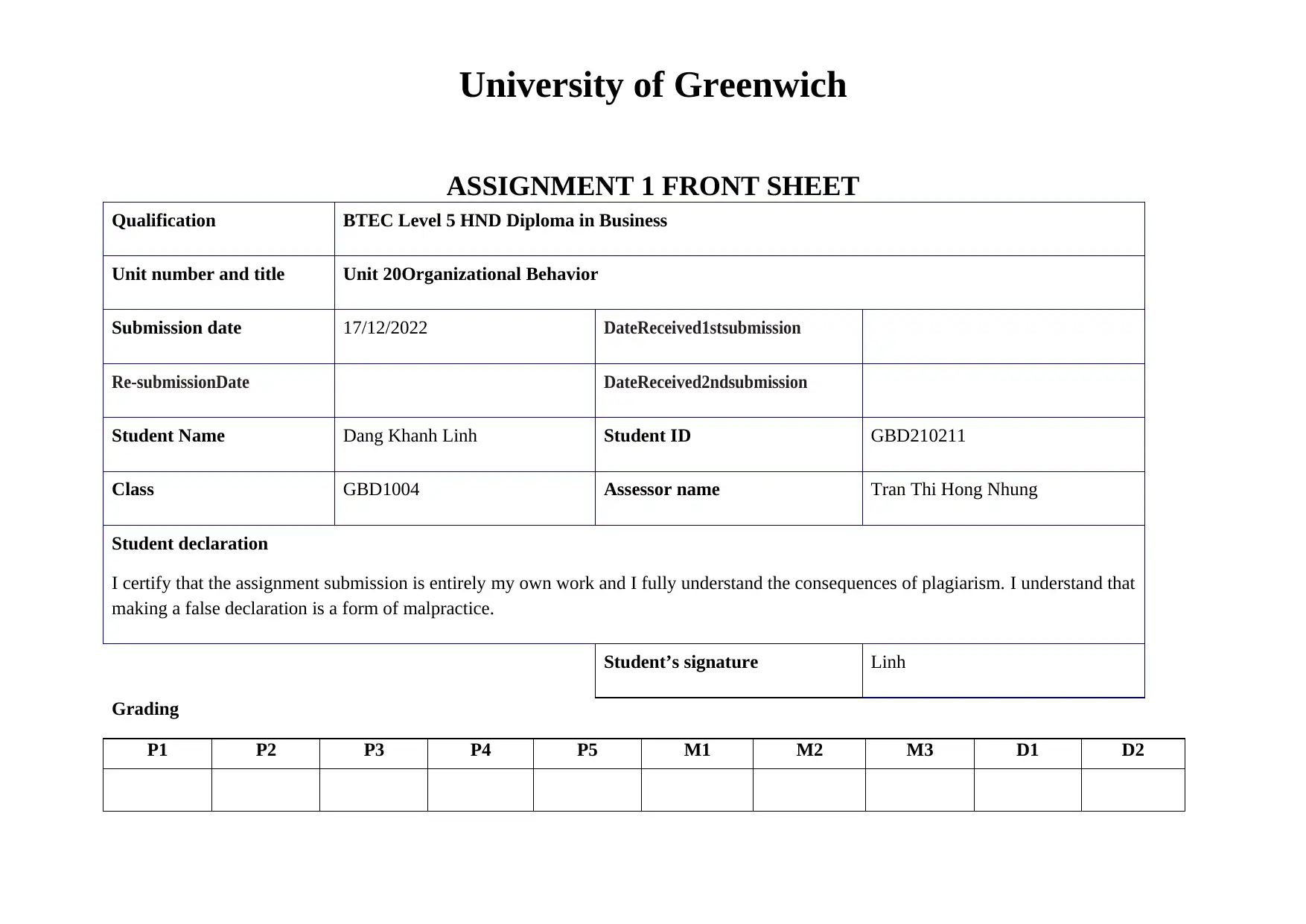
University of Greenwich
ASSIGNMENT 1 FRONT SHEET
Qualification BTEC Level 5 HND Diploma in Business
Unit number and title Unit 20Organizational Behavior
Submission date 17/12/2022 DateReceived1stsubmission
Re-submissionDate DateReceived2ndsubmission
Student Name Dang Khanh Linh Student ID GBD210211
Class GBD1004 Assessor name Tran Thi Hong Nhung
Student declaration
I certify that the assignment submission is entirely my own work and I fully understand the consequences of plagiarism. I understand that
making a false declaration is a form of malpractice.
Student’s signature Linh
Grading
P1 P2 P3 P4 P5 M1 M2 M3 D1 D2
ASSIGNMENT 1 FRONT SHEET
Qualification BTEC Level 5 HND Diploma in Business
Unit number and title Unit 20Organizational Behavior
Submission date 17/12/2022 DateReceived1stsubmission
Re-submissionDate DateReceived2ndsubmission
Student Name Dang Khanh Linh Student ID GBD210211
Class GBD1004 Assessor name Tran Thi Hong Nhung
Student declaration
I certify that the assignment submission is entirely my own work and I fully understand the consequences of plagiarism. I understand that
making a false declaration is a form of malpractice.
Student’s signature Linh
Grading
P1 P2 P3 P4 P5 M1 M2 M3 D1 D2
Paraphrase This Document
Need a fresh take? Get an instant paraphrase of this document with our AI Paraphraser
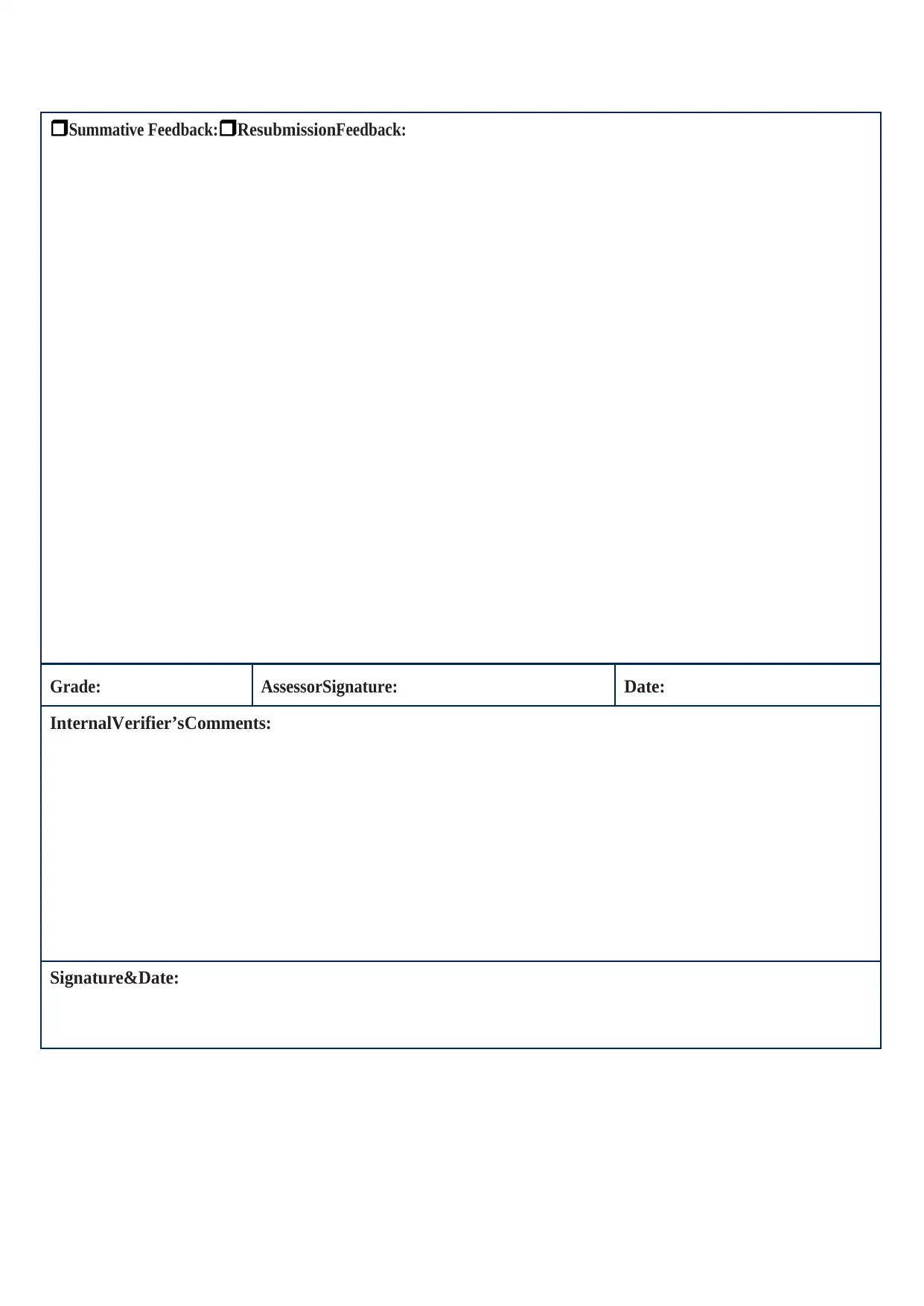
Summative Feedback: Resubmission Feedback:
Grade: AssessorSignature: Date:
InternalVerifier’sComments:
Signature&Date:
Grade: AssessorSignature: Date:
InternalVerifier’sComments:
Signature&Date:
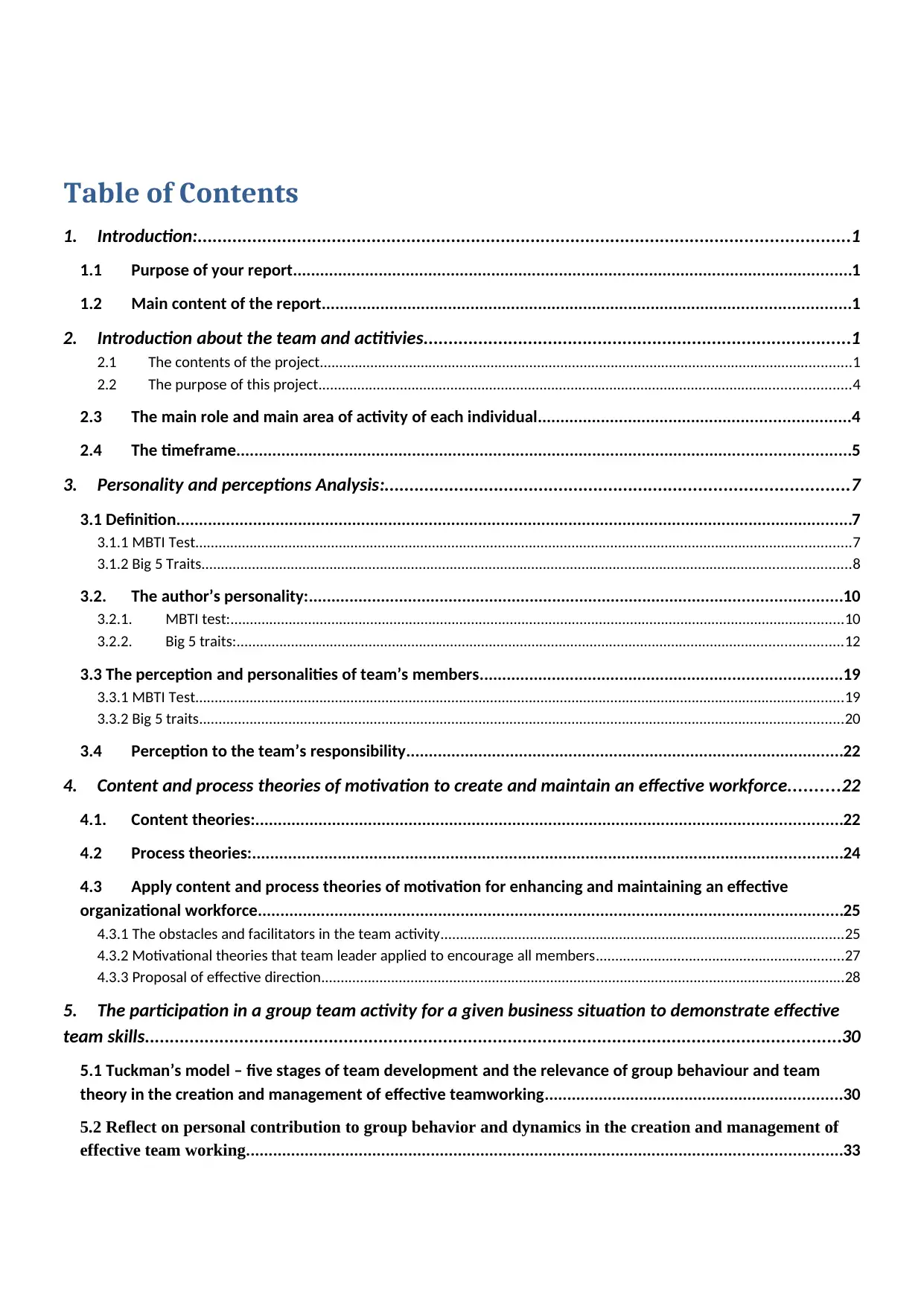
Table of Contents
1. Introduction:...................................................................................................................................1
1.1 Purpose of your report............................................................................................................................1
1.2 Main content of the report.....................................................................................................................1
2. Introduction about the team and actitivies......................................................................................1
2.1 The contents of the project.........................................................................................................................................1
2.2 The purpose of this project.........................................................................................................................................4
2.3 The main role and main area of activity of each individual.....................................................................4
2.4 The timeframe........................................................................................................................................5
3. Personality and perceptions Analysis:.............................................................................................7
3.1 Definition......................................................................................................................................................7
3.1.1 MBTI Test.........................................................................................................................................................................7
3.1.2 Big 5 Traits.......................................................................................................................................................................8
3.2. The author’s personality:......................................................................................................................10
3.2.1. MBTI test:..............................................................................................................................................................10
3.2.2. Big 5 traits:............................................................................................................................................................12
3.3 The perception and personalities of team’s members................................................................................19
3.3.1 MBTI Test.......................................................................................................................................................................19
3.3.2 Big 5 traits......................................................................................................................................................................20
3.4 Perception to the team’s responsibility.................................................................................................22
4. Content and process theories of motivation to create and maintain an effective workforce..........22
4.1. Content theories:..................................................................................................................................22
4.2 Process theories:...................................................................................................................................24
4.3 Apply content and process theories of motivation for enhancing and maintaining an effective
organizational workforce..................................................................................................................................25
4.3.1 The obstacles and facilitators in the team activity........................................................................................................25
4.3.2 Motivational theories that team leader applied to encourage all members................................................................27
4.3.3 Proposal of effective direction.......................................................................................................................................28
5. The participation in a group team activity for a given business situation to demonstrate effective
team skills............................................................................................................................................30
5.1 Tuckman’s model – five stages of team development and the relevance of group behaviour and team
theory in the creation and management of effective teamworking..................................................................30
5.2 Reflect on personal contribution to group behavior and dynamics in the creation and management of
effective team working....................................................................................................................................33
1. Introduction:...................................................................................................................................1
1.1 Purpose of your report............................................................................................................................1
1.2 Main content of the report.....................................................................................................................1
2. Introduction about the team and actitivies......................................................................................1
2.1 The contents of the project.........................................................................................................................................1
2.2 The purpose of this project.........................................................................................................................................4
2.3 The main role and main area of activity of each individual.....................................................................4
2.4 The timeframe........................................................................................................................................5
3. Personality and perceptions Analysis:.............................................................................................7
3.1 Definition......................................................................................................................................................7
3.1.1 MBTI Test.........................................................................................................................................................................7
3.1.2 Big 5 Traits.......................................................................................................................................................................8
3.2. The author’s personality:......................................................................................................................10
3.2.1. MBTI test:..............................................................................................................................................................10
3.2.2. Big 5 traits:............................................................................................................................................................12
3.3 The perception and personalities of team’s members................................................................................19
3.3.1 MBTI Test.......................................................................................................................................................................19
3.3.2 Big 5 traits......................................................................................................................................................................20
3.4 Perception to the team’s responsibility.................................................................................................22
4. Content and process theories of motivation to create and maintain an effective workforce..........22
4.1. Content theories:..................................................................................................................................22
4.2 Process theories:...................................................................................................................................24
4.3 Apply content and process theories of motivation for enhancing and maintaining an effective
organizational workforce..................................................................................................................................25
4.3.1 The obstacles and facilitators in the team activity........................................................................................................25
4.3.2 Motivational theories that team leader applied to encourage all members................................................................27
4.3.3 Proposal of effective direction.......................................................................................................................................28
5. The participation in a group team activity for a given business situation to demonstrate effective
team skills............................................................................................................................................30
5.1 Tuckman’s model – five stages of team development and the relevance of group behaviour and team
theory in the creation and management of effective teamworking..................................................................30
5.2 Reflect on personal contribution to group behavior and dynamics in the creation and management of
effective team working....................................................................................................................................33
⊘ This is a preview!⊘
Do you want full access?
Subscribe today to unlock all pages.

Trusted by 1+ million students worldwide
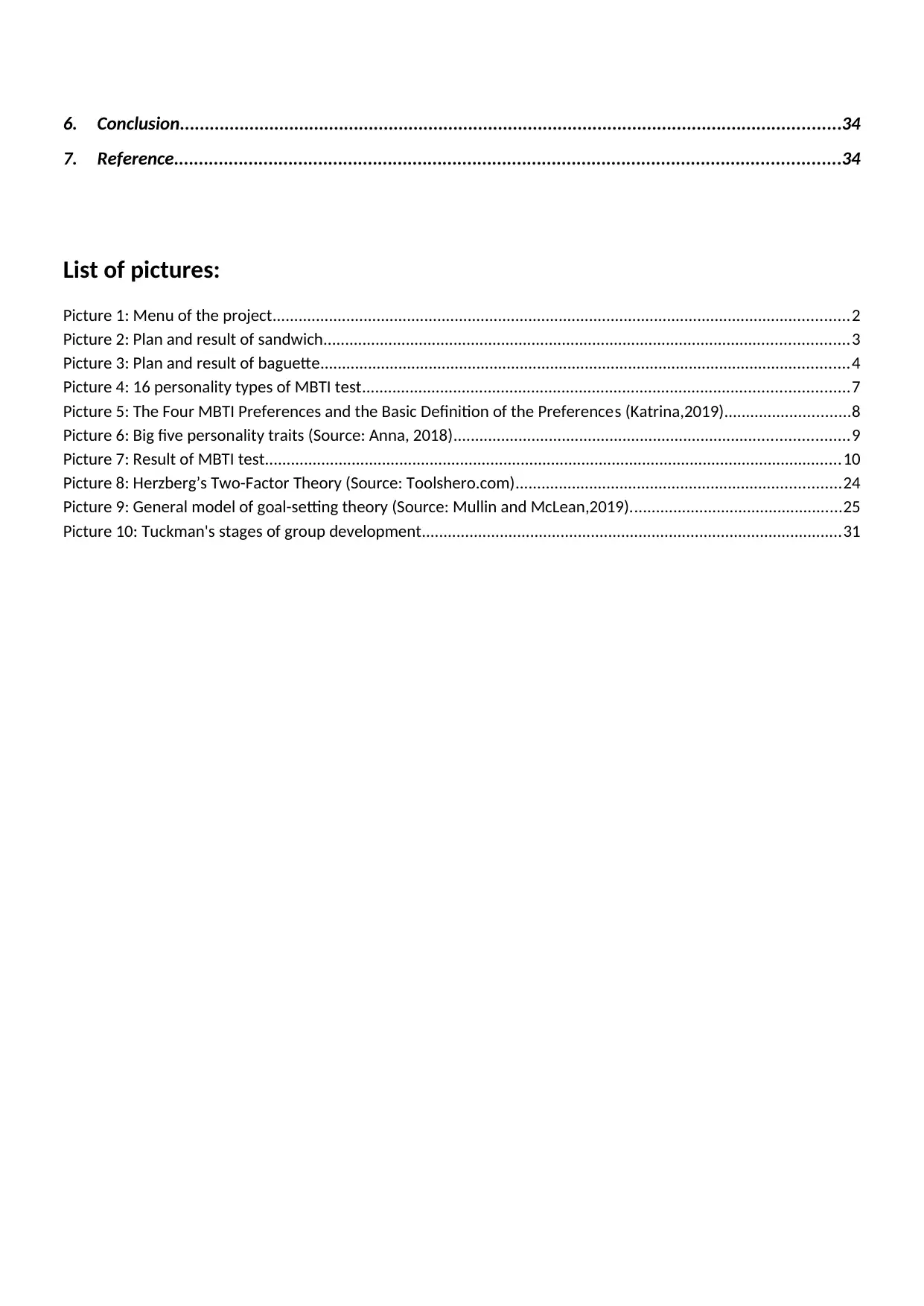
6. Conclusion.....................................................................................................................................34
7. Reference......................................................................................................................................34
List of pictures:
Picture 1: Menu of the project.....................................................................................................................................2
Picture 2: Plan and result of sandwich.........................................................................................................................3
Picture 3: Plan and result of baguette..........................................................................................................................4
Picture 4: 16 personality types of MBTI test................................................................................................................7
Picture 5: The Four MBTI Preferences and the Basic Definition of the Preferences (Katrina,2019).............................8
Picture 6: Big five personality traits (Source: Anna, 2018)...........................................................................................9
Picture 7: Result of MBTI test.....................................................................................................................................10
Picture 8: Herzberg’s Two-Factor Theory (Source: Toolshero.com)...........................................................................24
Picture 9: General model of goal-setting theory (Source: Mullin and McLean,2019).................................................25
Picture 10: Tuckman's stages of group development.................................................................................................31
7. Reference......................................................................................................................................34
List of pictures:
Picture 1: Menu of the project.....................................................................................................................................2
Picture 2: Plan and result of sandwich.........................................................................................................................3
Picture 3: Plan and result of baguette..........................................................................................................................4
Picture 4: 16 personality types of MBTI test................................................................................................................7
Picture 5: The Four MBTI Preferences and the Basic Definition of the Preferences (Katrina,2019).............................8
Picture 6: Big five personality traits (Source: Anna, 2018)...........................................................................................9
Picture 7: Result of MBTI test.....................................................................................................................................10
Picture 8: Herzberg’s Two-Factor Theory (Source: Toolshero.com)...........................................................................24
Picture 9: General model of goal-setting theory (Source: Mullin and McLean,2019).................................................25
Picture 10: Tuckman's stages of group development.................................................................................................31
Paraphrase This Document
Need a fresh take? Get an instant paraphrase of this document with our AI Paraphraser
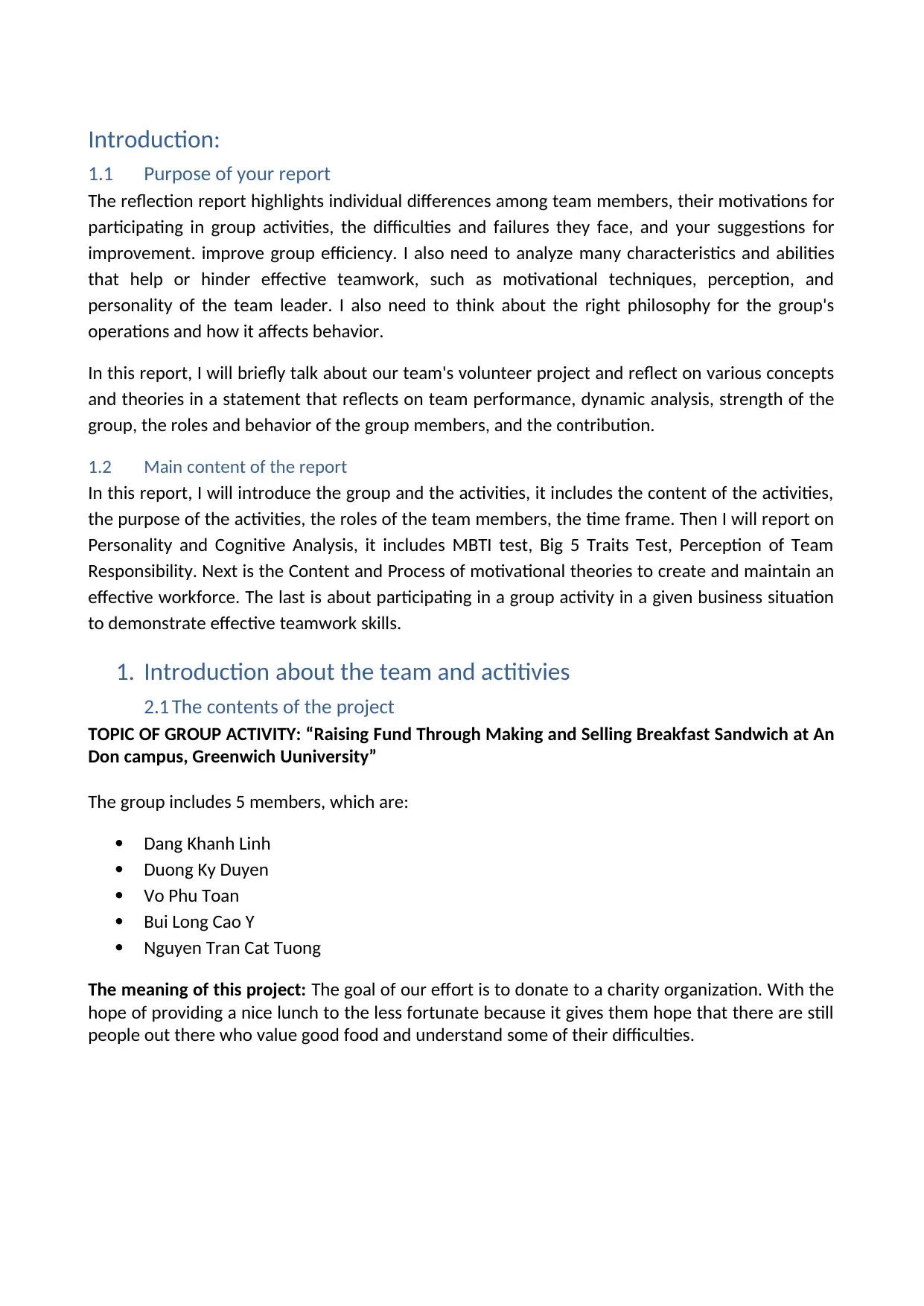
Introduction:
1.1 Purpose of your report
The reflection report highlights individual differences among team members, their motivations for
participating in group activities, the difficulties and failures they face, and your suggestions for
improvement. improve group efficiency. I also need to analyze many characteristics and abilities
that help or hinder effective teamwork, such as motivational techniques, perception, and
personality of the team leader. I also need to think about the right philosophy for the group's
operations and how it affects behavior.
In this report, I will briefly talk about our team's volunteer project and reflect on various concepts
and theories in a statement that reflects on team performance, dynamic analysis, strength of the
group, the roles and behavior of the group members, and the contribution.
1.2 Main content of the report
In this report, I will introduce the group and the activities, it includes the content of the activities,
the purpose of the activities, the roles of the team members, the time frame. Then I will report on
Personality and Cognitive Analysis, it includes MBTI test, Big 5 Traits Test, Perception of Team
Responsibility. Next is the Content and Process of motivational theories to create and maintain an
effective workforce. The last is about participating in a group activity in a given business situation
to demonstrate effective teamwork skills.
1. Introduction about the team and actitivies
2.1 The contents of the project
TOPIC OF GROUP ACTIVITY: “Raising Fund Through Making and Selling Breakfast Sandwich at An
Don campus, Greenwich Uuniversity”
The group includes 5 members, which are:
Dang Khanh Linh
Duong Ky Duyen
Vo Phu Toan
Bui Long Cao Y
Nguyen Tran Cat Tuong
The meaning of this project: The goal of our effort is to donate to a charity organization. With the
hope of providing a nice lunch to the less fortunate because it gives them hope that there are still
people out there who value good food and understand some of their difficulties.
1.1 Purpose of your report
The reflection report highlights individual differences among team members, their motivations for
participating in group activities, the difficulties and failures they face, and your suggestions for
improvement. improve group efficiency. I also need to analyze many characteristics and abilities
that help or hinder effective teamwork, such as motivational techniques, perception, and
personality of the team leader. I also need to think about the right philosophy for the group's
operations and how it affects behavior.
In this report, I will briefly talk about our team's volunteer project and reflect on various concepts
and theories in a statement that reflects on team performance, dynamic analysis, strength of the
group, the roles and behavior of the group members, and the contribution.
1.2 Main content of the report
In this report, I will introduce the group and the activities, it includes the content of the activities,
the purpose of the activities, the roles of the team members, the time frame. Then I will report on
Personality and Cognitive Analysis, it includes MBTI test, Big 5 Traits Test, Perception of Team
Responsibility. Next is the Content and Process of motivational theories to create and maintain an
effective workforce. The last is about participating in a group activity in a given business situation
to demonstrate effective teamwork skills.
1. Introduction about the team and actitivies
2.1 The contents of the project
TOPIC OF GROUP ACTIVITY: “Raising Fund Through Making and Selling Breakfast Sandwich at An
Don campus, Greenwich Uuniversity”
The group includes 5 members, which are:
Dang Khanh Linh
Duong Ky Duyen
Vo Phu Toan
Bui Long Cao Y
Nguyen Tran Cat Tuong
The meaning of this project: The goal of our effort is to donate to a charity organization. With the
hope of providing a nice lunch to the less fortunate because it gives them hope that there are still
people out there who value good food and understand some of their difficulties.
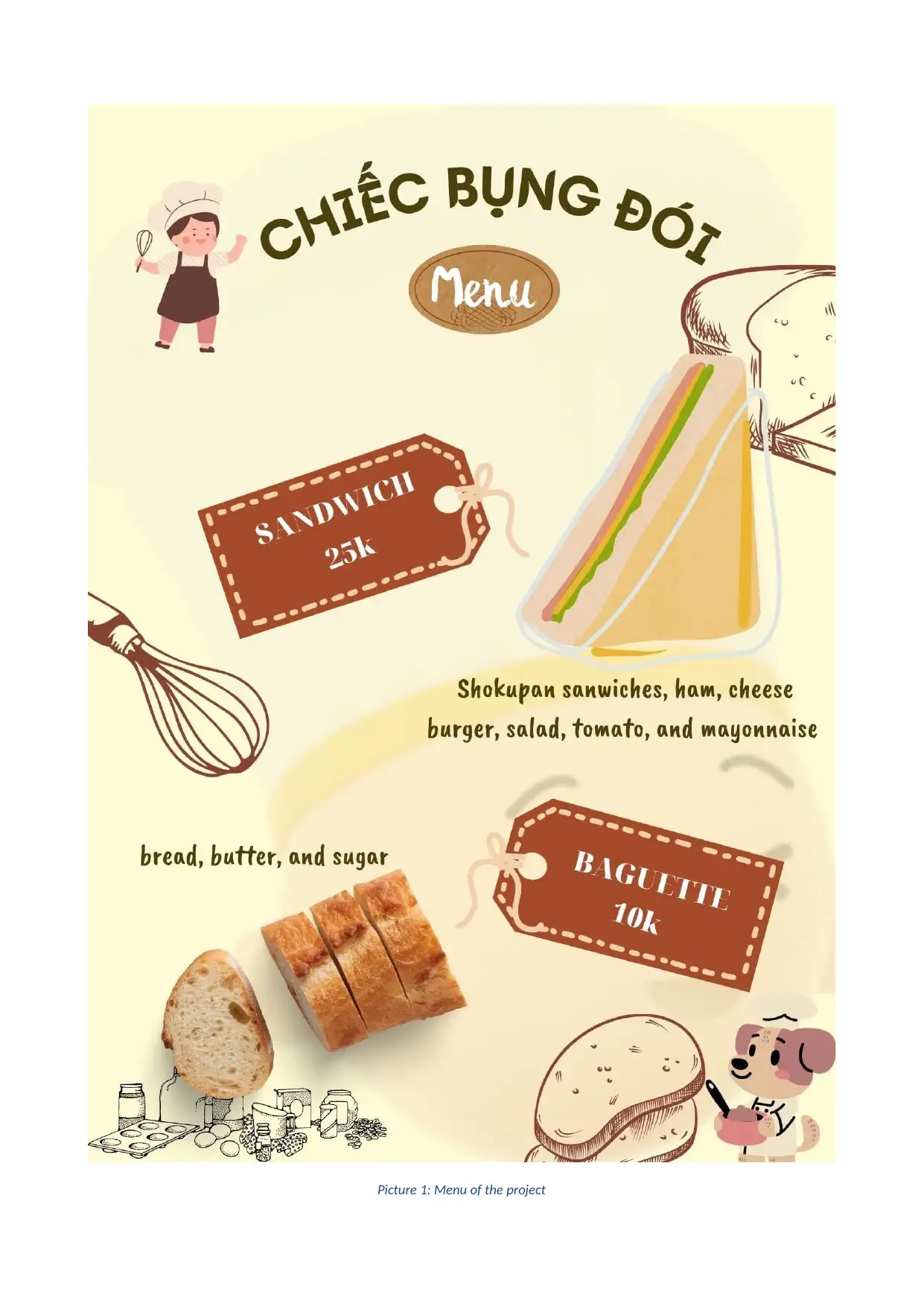
Picture 1: Menu of the project
⊘ This is a preview!⊘
Do you want full access?
Subscribe today to unlock all pages.

Trusted by 1+ million students worldwide
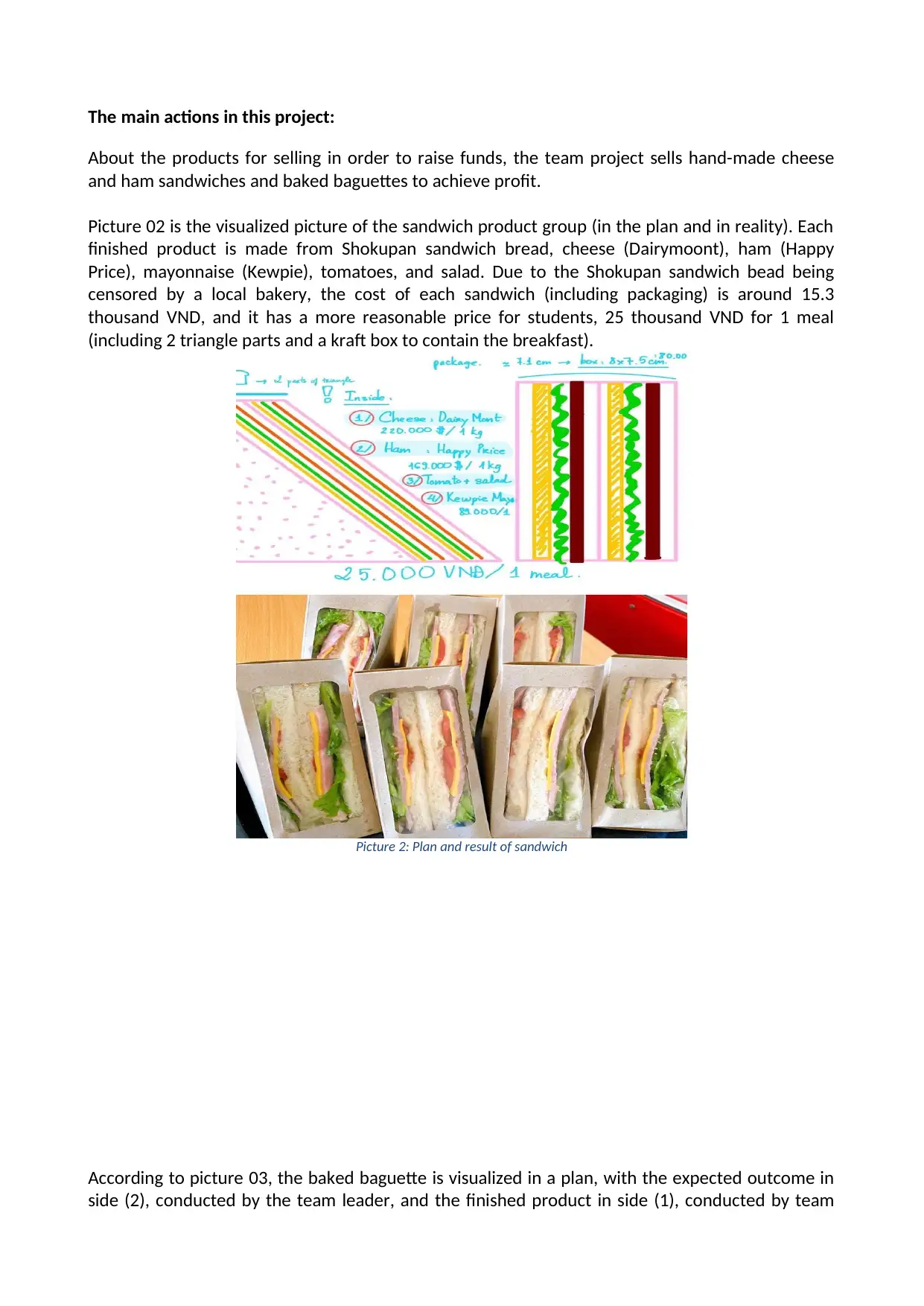
The main actions in this project:
About the products for selling in order to raise funds, the team project sells hand-made cheese
and ham sandwiches and baked baguettes to achieve profit.
Picture 02 is the visualized picture of the sandwich product group (in the plan and in reality). Each
finished product is made from Shokupan sandwich bread, cheese (Dairymoont), ham (Happy
Price), mayonnaise (Kewpie), tomatoes, and salad. Due to the Shokupan sandwich bead being
censored by a local bakery, the cost of each sandwich (including packaging) is around 15.3
thousand VND, and it has a more reasonable price for students, 25 thousand VND for 1 meal
(including 2 triangle parts and a kraft box to contain the breakfast).
Picture 2: Plan and result of sandwich
According to picture 03, the baked baguette is visualized in a plan, with the expected outcome in
side (2), conducted by the team leader, and the finished product in side (1), conducted by team
About the products for selling in order to raise funds, the team project sells hand-made cheese
and ham sandwiches and baked baguettes to achieve profit.
Picture 02 is the visualized picture of the sandwich product group (in the plan and in reality). Each
finished product is made from Shokupan sandwich bread, cheese (Dairymoont), ham (Happy
Price), mayonnaise (Kewpie), tomatoes, and salad. Due to the Shokupan sandwich bead being
censored by a local bakery, the cost of each sandwich (including packaging) is around 15.3
thousand VND, and it has a more reasonable price for students, 25 thousand VND for 1 meal
(including 2 triangle parts and a kraft box to contain the breakfast).
Picture 2: Plan and result of sandwich
According to picture 03, the baked baguette is visualized in a plan, with the expected outcome in
side (2), conducted by the team leader, and the finished product in side (1), conducted by team
Paraphrase This Document
Need a fresh take? Get an instant paraphrase of this document with our AI Paraphraser
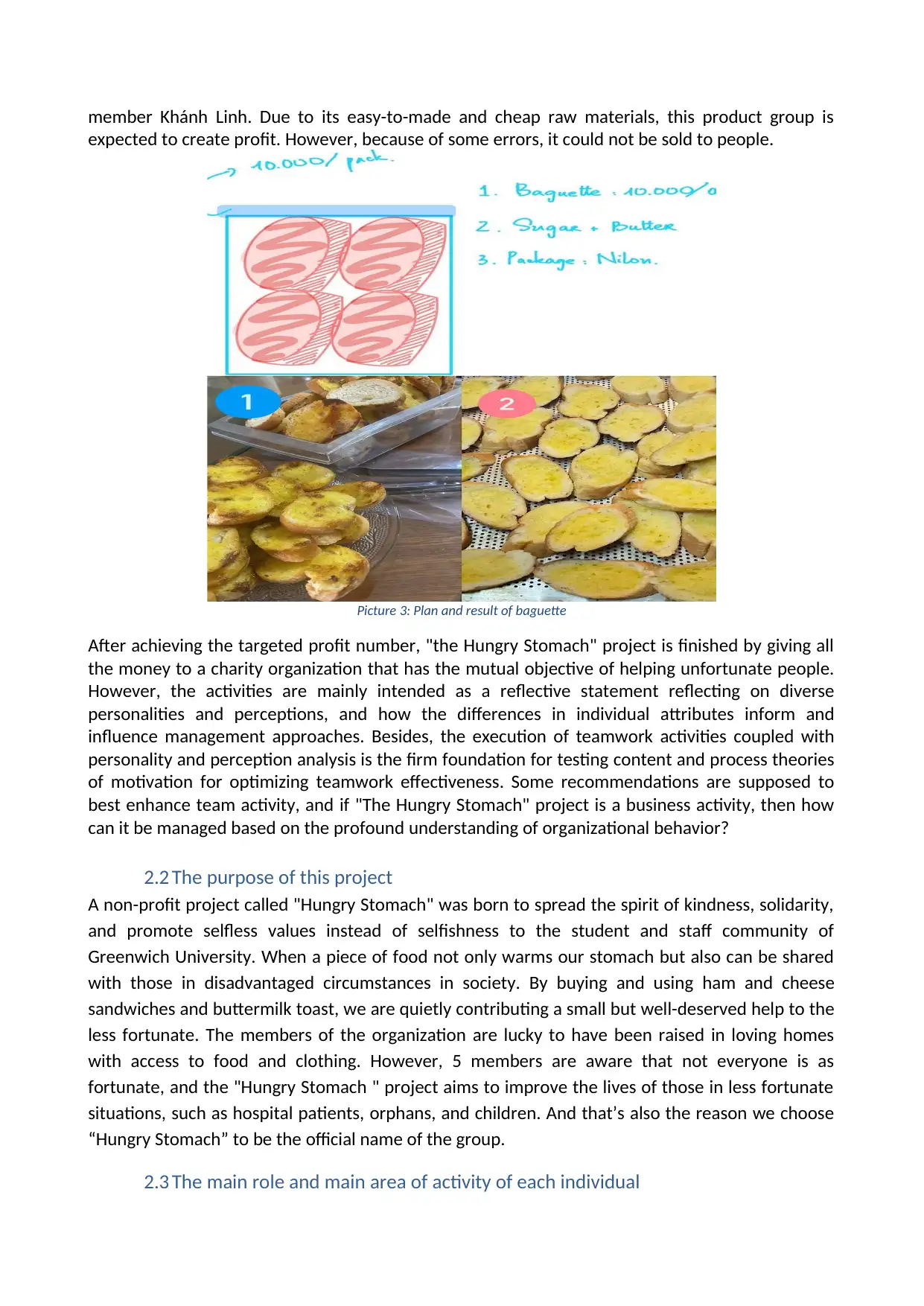
member Khánh Linh. Due to its easy-to-made and cheap raw materials, this product group is
expected to create profit. However, because of some errors, it could not be sold to people.
Picture 3: Plan and result of baguette
After achieving the targeted profit number, "the Hungry Stomach" project is finished by giving all
the money to a charity organization that has the mutual objective of helping unfortunate people.
However, the activities are mainly intended as a reflective statement reflecting on diverse
personalities and perceptions, and how the differences in individual attributes inform and
influence management approaches. Besides, the execution of teamwork activities coupled with
personality and perception analysis is the firm foundation for testing content and process theories
of motivation for optimizing teamwork effectiveness. Some recommendations are supposed to
best enhance team activity, and if "The Hungry Stomach" project is a business activity, then how
can it be managed based on the profound understanding of organizational behavior?
2.2 The purpose of this project
A non-profit project called "Hungry Stomach" was born to spread the spirit of kindness, solidarity,
and promote selfless values instead of selfishness to the student and staff community of
Greenwich University. When a piece of food not only warms our stomach but also can be shared
with those in disadvantaged circumstances in society. By buying and using ham and cheese
sandwiches and buttermilk toast, we are quietly contributing a small but well-deserved help to the
less fortunate. The members of the organization are lucky to have been raised in loving homes
with access to food and clothing. However, 5 members are aware that not everyone is as
fortunate, and the "Hungry Stomach " project aims to improve the lives of those in less fortunate
situations, such as hospital patients, orphans, and children. And that’s also the reason we choose
“Hungry Stomach” to be the official name of the group.
2.3 The main role and main area of activity of each individual
expected to create profit. However, because of some errors, it could not be sold to people.
Picture 3: Plan and result of baguette
After achieving the targeted profit number, "the Hungry Stomach" project is finished by giving all
the money to a charity organization that has the mutual objective of helping unfortunate people.
However, the activities are mainly intended as a reflective statement reflecting on diverse
personalities and perceptions, and how the differences in individual attributes inform and
influence management approaches. Besides, the execution of teamwork activities coupled with
personality and perception analysis is the firm foundation for testing content and process theories
of motivation for optimizing teamwork effectiveness. Some recommendations are supposed to
best enhance team activity, and if "The Hungry Stomach" project is a business activity, then how
can it be managed based on the profound understanding of organizational behavior?
2.2 The purpose of this project
A non-profit project called "Hungry Stomach" was born to spread the spirit of kindness, solidarity,
and promote selfless values instead of selfishness to the student and staff community of
Greenwich University. When a piece of food not only warms our stomach but also can be shared
with those in disadvantaged circumstances in society. By buying and using ham and cheese
sandwiches and buttermilk toast, we are quietly contributing a small but well-deserved help to the
less fortunate. The members of the organization are lucky to have been raised in loving homes
with access to food and clothing. However, 5 members are aware that not everyone is as
fortunate, and the "Hungry Stomach " project aims to improve the lives of those in less fortunate
situations, such as hospital patients, orphans, and children. And that’s also the reason we choose
“Hungry Stomach” to be the official name of the group.
2.3 The main role and main area of activity of each individual
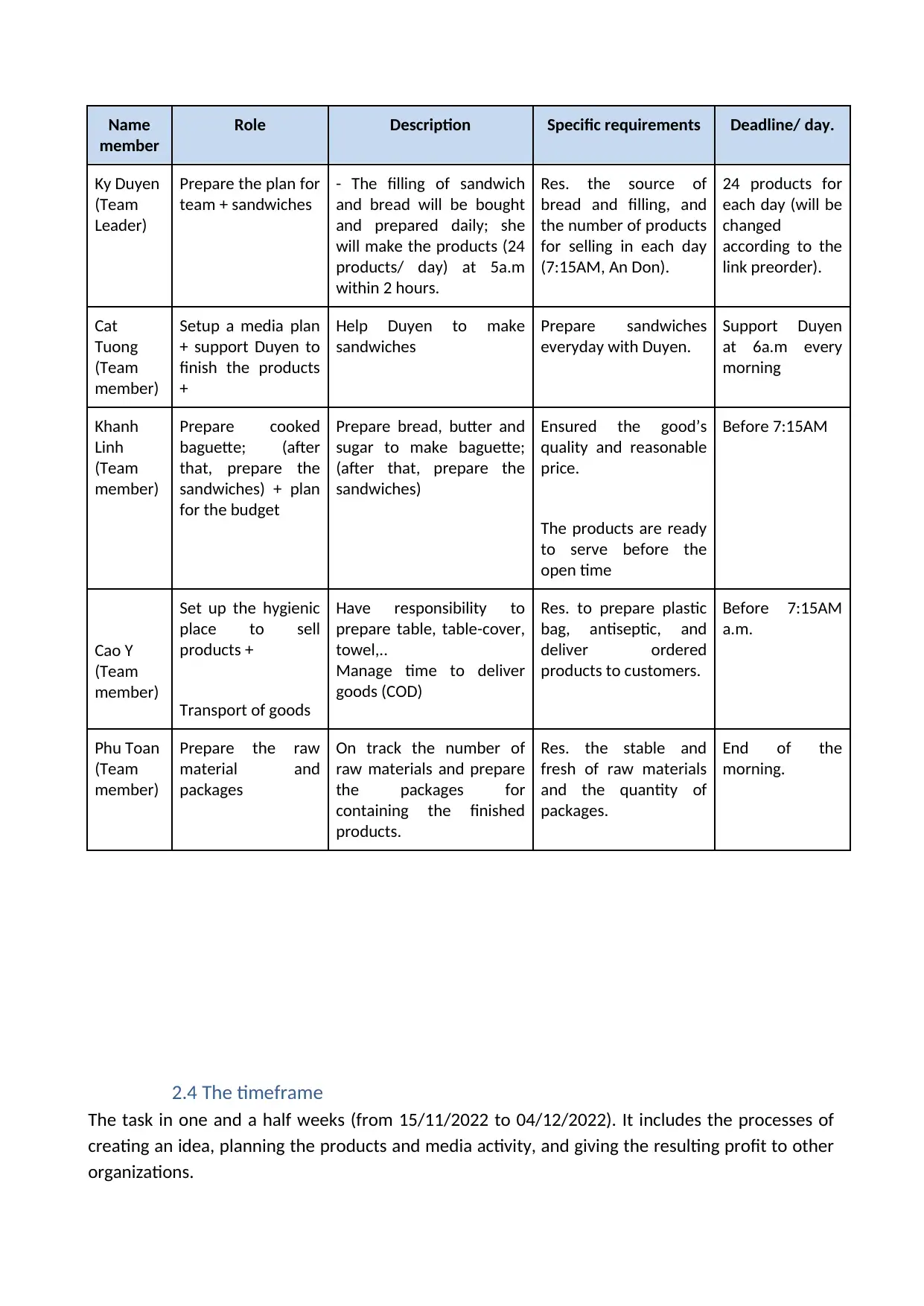
Name
member
Role Description Specific requirements Deadline/ day.
Ky Duyen
(Team
Leader)
Prepare the plan for
team + sandwiches
- The filling of sandwich
and bread will be bought
and prepared daily; she
will make the products (24
products/ day) at 5a.m
within 2 hours.
Res. the source of
bread and filling, and
the number of products
for selling in each day
(7:15AM, An Don).
24 products for
each day (will be
changed
according to the
link preorder).
Cat
Tuong
(Team
member)
Setup a media plan
+ support Duyen to
finish the products
+
Help Duyen to make
sandwiches
Prepare sandwiches
everyday with Duyen.
Support Duyen
at 6a.m every
morning
Khanh
Linh
(Team
member)
Prepare cooked
baguette; (after
that, prepare the
sandwiches) + plan
for the budget
Prepare bread, butter and
sugar to make baguette;
(after that, prepare the
sandwiches)
Ensured the good’s
quality and reasonable
price.
The products are ready
to serve before the
open time
Before 7:15AM
Cao Y
(Team
member)
Set up the hygienic
place to sell
products +
Transport of goods
Have responsibility to
prepare table, table-cover,
towel,..
Manage time to deliver
goods (COD)
Res. to prepare plastic
bag, antiseptic, and
deliver ordered
products to customers.
Before 7:15AM
a.m.
Phu Toan
(Team
member)
Prepare the raw
material and
packages
On track the number of
raw materials and prepare
the packages for
containing the finished
products.
Res. the stable and
fresh of raw materials
and the quantity of
packages.
End of the
morning.
2.4 The timeframe
The task in one and a half weeks (from 15/11/2022 to 04/12/2022). It includes the processes of
creating an idea, planning the products and media activity, and giving the resulting profit to other
organizations.
member
Role Description Specific requirements Deadline/ day.
Ky Duyen
(Team
Leader)
Prepare the plan for
team + sandwiches
- The filling of sandwich
and bread will be bought
and prepared daily; she
will make the products (24
products/ day) at 5a.m
within 2 hours.
Res. the source of
bread and filling, and
the number of products
for selling in each day
(7:15AM, An Don).
24 products for
each day (will be
changed
according to the
link preorder).
Cat
Tuong
(Team
member)
Setup a media plan
+ support Duyen to
finish the products
+
Help Duyen to make
sandwiches
Prepare sandwiches
everyday with Duyen.
Support Duyen
at 6a.m every
morning
Khanh
Linh
(Team
member)
Prepare cooked
baguette; (after
that, prepare the
sandwiches) + plan
for the budget
Prepare bread, butter and
sugar to make baguette;
(after that, prepare the
sandwiches)
Ensured the good’s
quality and reasonable
price.
The products are ready
to serve before the
open time
Before 7:15AM
Cao Y
(Team
member)
Set up the hygienic
place to sell
products +
Transport of goods
Have responsibility to
prepare table, table-cover,
towel,..
Manage time to deliver
goods (COD)
Res. to prepare plastic
bag, antiseptic, and
deliver ordered
products to customers.
Before 7:15AM
a.m.
Phu Toan
(Team
member)
Prepare the raw
material and
packages
On track the number of
raw materials and prepare
the packages for
containing the finished
products.
Res. the stable and
fresh of raw materials
and the quantity of
packages.
End of the
morning.
2.4 The timeframe
The task in one and a half weeks (from 15/11/2022 to 04/12/2022). It includes the processes of
creating an idea, planning the products and media activity, and giving the resulting profit to other
organizations.
⊘ This is a preview!⊘
Do you want full access?
Subscribe today to unlock all pages.

Trusted by 1+ million students worldwide
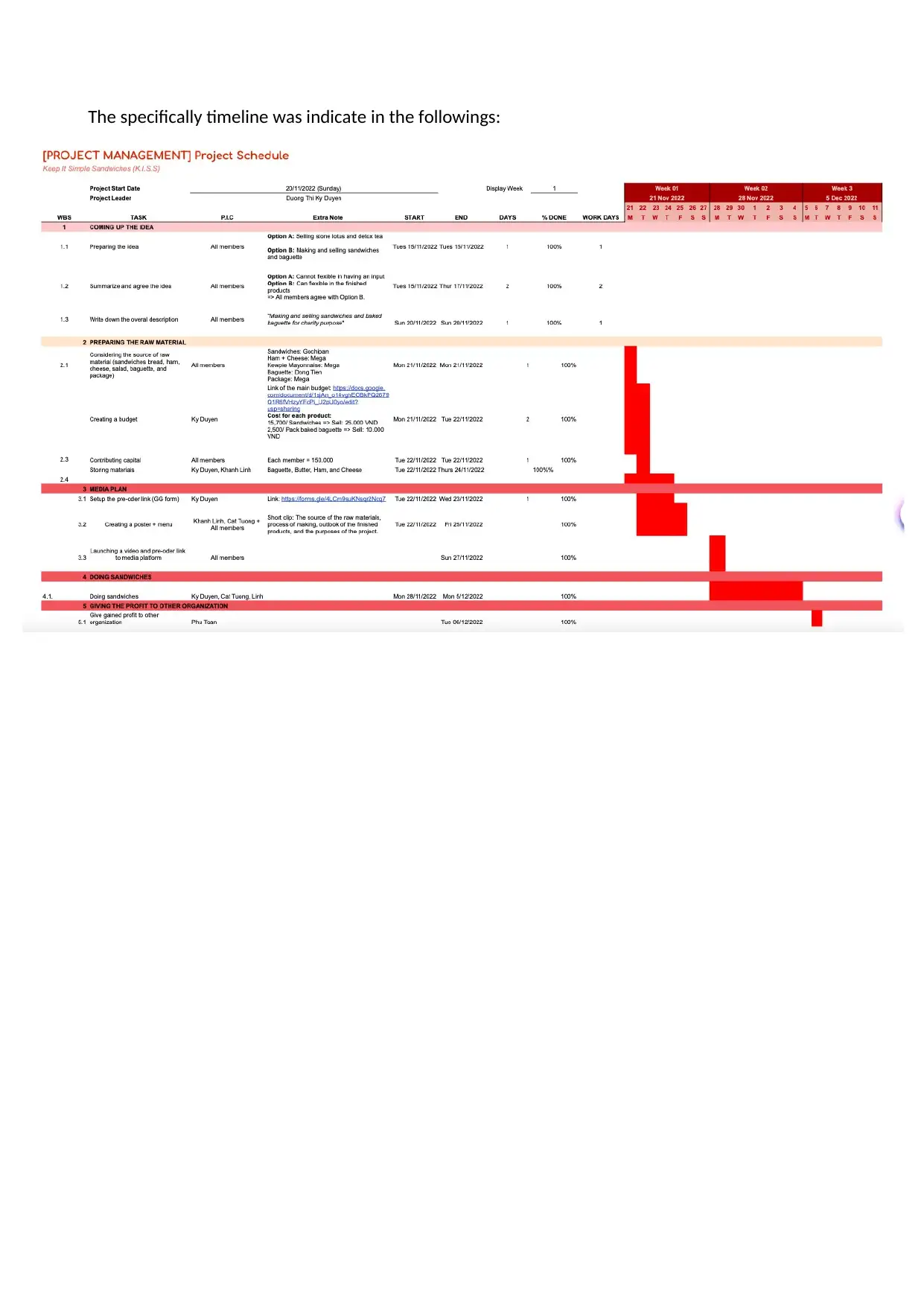
The specifically timeline was indicate in the followings:
Paraphrase This Document
Need a fresh take? Get an instant paraphrase of this document with our AI Paraphraser
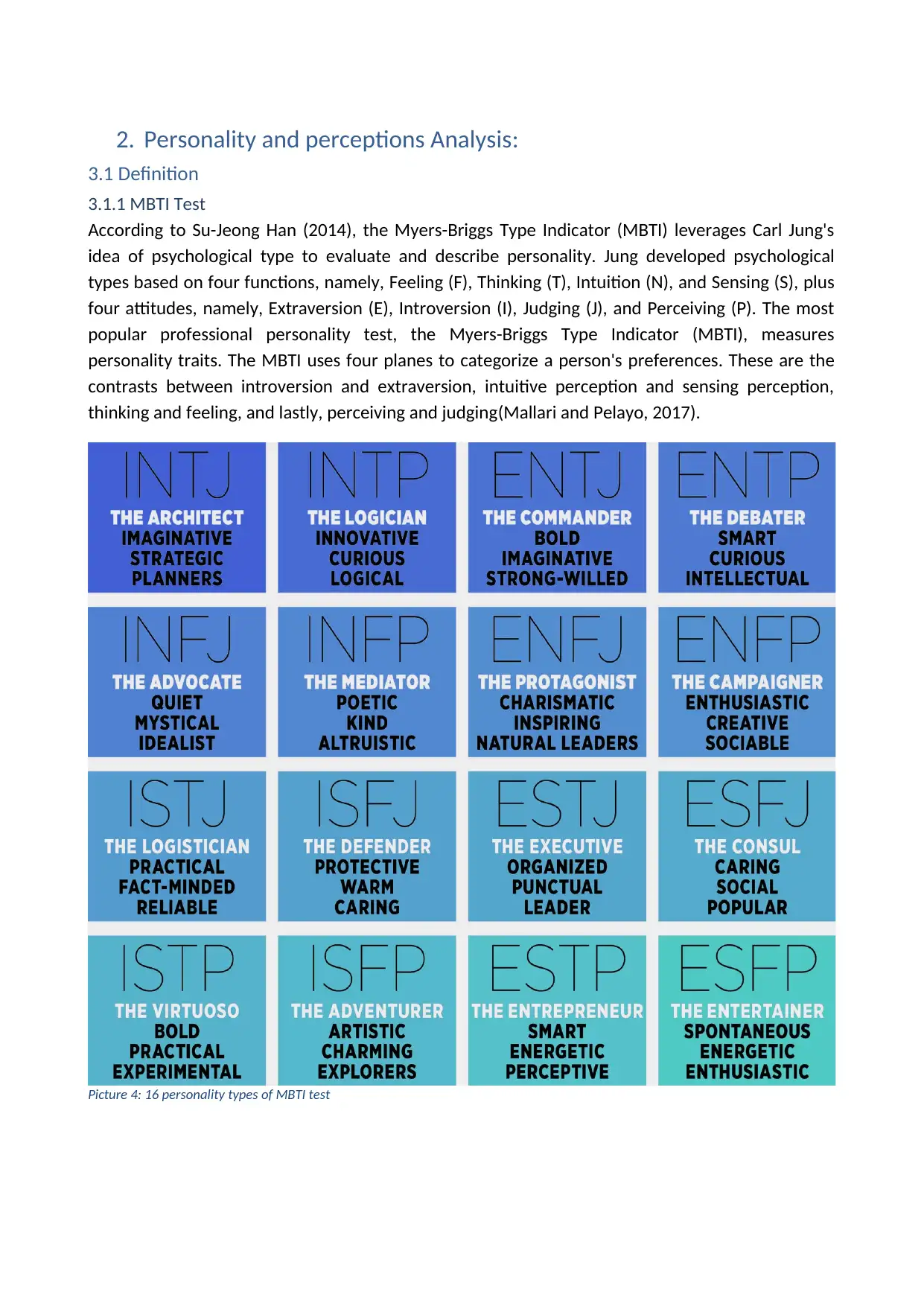
2. Personality and perceptions Analysis:
3.1 Definition
3.1.1 MBTI Test
According to Su-Jeong Han (2014), the Myers-Briggs Type Indicator (MBTI) leverages Carl Jung's
idea of psychological type to evaluate and describe personality. Jung developed psychological
types based on four functions, namely, Feeling (F), Thinking (T), Intuition (N), and Sensing (S), plus
four attitudes, namely, Extraversion (E), Introversion (I), Judging (J), and Perceiving (P). The most
popular professional personality test, the Myers-Briggs Type Indicator (MBTI), measures
personality traits. The MBTI uses four planes to categorize a person's preferences. These are the
contrasts between introversion and extraversion, intuitive perception and sensing perception,
thinking and feeling, and lastly, perceiving and judging(Mallari and Pelayo, 2017).
Picture 4: 16 personality types of MBTI test
3.1 Definition
3.1.1 MBTI Test
According to Su-Jeong Han (2014), the Myers-Briggs Type Indicator (MBTI) leverages Carl Jung's
idea of psychological type to evaluate and describe personality. Jung developed psychological
types based on four functions, namely, Feeling (F), Thinking (T), Intuition (N), and Sensing (S), plus
four attitudes, namely, Extraversion (E), Introversion (I), Judging (J), and Perceiving (P). The most
popular professional personality test, the Myers-Briggs Type Indicator (MBTI), measures
personality traits. The MBTI uses four planes to categorize a person's preferences. These are the
contrasts between introversion and extraversion, intuitive perception and sensing perception,
thinking and feeling, and lastly, perceiving and judging(Mallari and Pelayo, 2017).
Picture 4: 16 personality types of MBTI test
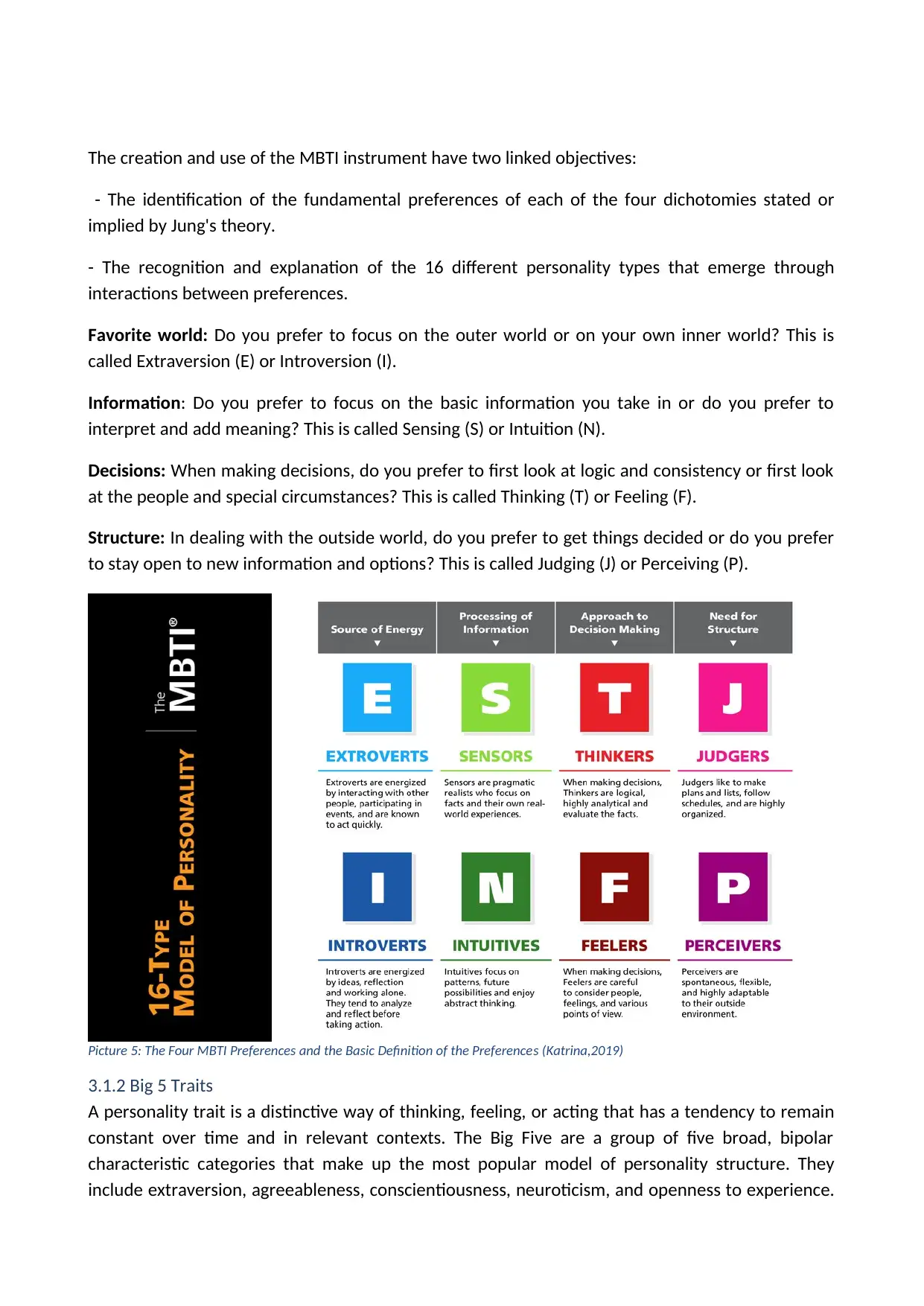
The creation and use of the MBTI instrument have two linked objectives:
- The identification of the fundamental preferences of each of the four dichotomies stated or
implied by Jung's theory.
- The recognition and explanation of the 16 different personality types that emerge through
interactions between preferences.
Favorite world: Do you prefer to focus on the outer world or on your own inner world? This is
called Extraversion (E) or Introversion (I).
Information: Do you prefer to focus on the basic information you take in or do you prefer to
interpret and add meaning? This is called Sensing (S) or Intuition (N).
Decisions: When making decisions, do you prefer to first look at logic and consistency or first look
at the people and special circumstances? This is called Thinking (T) or Feeling (F).
Structure: In dealing with the outside world, do you prefer to get things decided or do you prefer
to stay open to new information and options? This is called Judging (J) or Perceiving (P).
Picture 5: The Four MBTI Preferences and the Basic Definition of the Preferences (Katrina,2019)
3.1.2 Big 5 Traits
A personality trait is a distinctive way of thinking, feeling, or acting that has a tendency to remain
constant over time and in relevant contexts. The Big Five are a group of five broad, bipolar
characteristic categories that make up the most popular model of personality structure. They
include extraversion, agreeableness, conscientiousness, neuroticism, and openness to experience.
- The identification of the fundamental preferences of each of the four dichotomies stated or
implied by Jung's theory.
- The recognition and explanation of the 16 different personality types that emerge through
interactions between preferences.
Favorite world: Do you prefer to focus on the outer world or on your own inner world? This is
called Extraversion (E) or Introversion (I).
Information: Do you prefer to focus on the basic information you take in or do you prefer to
interpret and add meaning? This is called Sensing (S) or Intuition (N).
Decisions: When making decisions, do you prefer to first look at logic and consistency or first look
at the people and special circumstances? This is called Thinking (T) or Feeling (F).
Structure: In dealing with the outside world, do you prefer to get things decided or do you prefer
to stay open to new information and options? This is called Judging (J) or Perceiving (P).
Picture 5: The Four MBTI Preferences and the Basic Definition of the Preferences (Katrina,2019)
3.1.2 Big 5 Traits
A personality trait is a distinctive way of thinking, feeling, or acting that has a tendency to remain
constant over time and in relevant contexts. The Big Five are a group of five broad, bipolar
characteristic categories that make up the most popular model of personality structure. They
include extraversion, agreeableness, conscientiousness, neuroticism, and openness to experience.
⊘ This is a preview!⊘
Do you want full access?
Subscribe today to unlock all pages.

Trusted by 1+ million students worldwide
1 out of 45
Related Documents
Your All-in-One AI-Powered Toolkit for Academic Success.
+13062052269
info@desklib.com
Available 24*7 on WhatsApp / Email
![[object Object]](/_next/static/media/star-bottom.7253800d.svg)
Unlock your academic potential
Copyright © 2020–2025 A2Z Services. All Rights Reserved. Developed and managed by ZUCOL.




